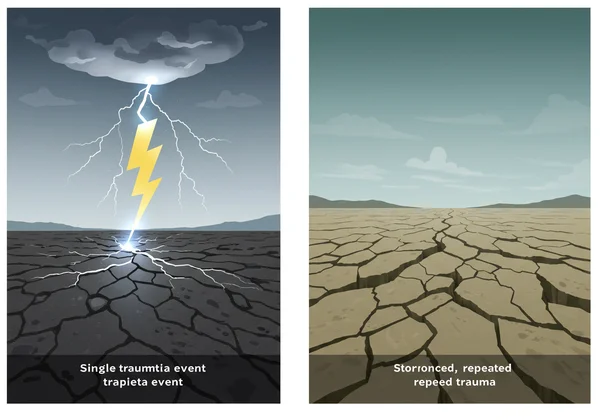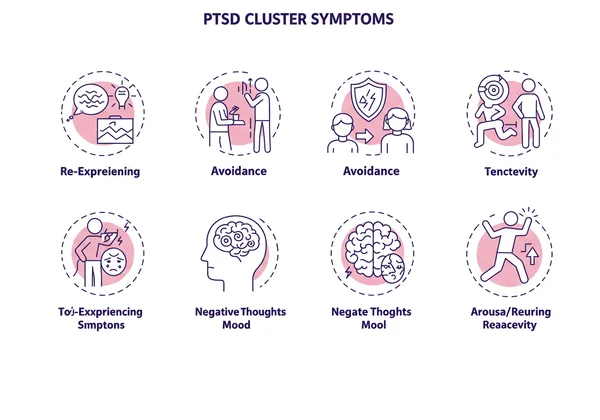Complex PTSD Test vs. PTSD: Understanding Your Trauma
Have you ever felt like the descriptions of Post-Traumatic Stress Disorder (PTSD) don't quite fit what you’re going through? Perhaps your struggles stem not from a single, isolated event, but from a long period of distress, leaving you with wounds that feel deeper and more complex. You are not alone in this feeling, and finding the right language for your experience is a crucial step toward healing. For anyone wondering, "Do I have PTSD or am I just traumatized?", understanding the distinction between PTSD and Complex PTSD (cPTSD) can be life-changing.
In this article, we'll compassionately explore the critical differences between these two conditions. By learning to identify the unique signs, you can better understand your own story. An online complex ptsd test can be a valuable tool on this journey, offering a private space to start to understand your feelings and gain the clarity you deserve.

Understanding Traditional PTSD: PTSD symptoms and Causes
Post-Traumatic Stress Disorder is a mental health condition that can occur in people who have experienced or witnessed a shocking, scary, or dangerous event. While the human mind is resilient, some traumatic experiences can overwhelm our ability to cope, causing symptoms that persist long after the danger has passed.
Defining PTSD: When Trauma Becomes a Disorder
Trauma itself is an event, but PTSD is the lasting aftermath. It’s when your nervous system gets stuck in "high alert," and the memory of the trauma continues to intrude on your present-day life. According to established guidelines like the DSM-5, a diagnosis is considered when these symptoms last for more than a month and significantly disrupt daily functioning. The core of PTSD is often tied to the feeling of powerlessness during the event and the brain’s struggle to process the re-experiencing of that memory.
The Four Clusters of PTSD Symptoms Explained
To make it clearer, mental health professionals group PTSD symptoms into four main categories. Seeing if these clusters resonate with you can be a helpful first step.
-
Re-experiencing Symptoms: This is when you involuntarily re-live the traumatic event. It can manifest as intrusive memories, distressing nightmares, or vivid flashbacks where you feel as if the event is happening all over again.
-
Avoidance Symptoms: A person may go to great lengths to avoid anything that reminds them of the trauma. This can mean avoiding people, places, activities, or even thoughts and feelings associated with the event.
-
Negative Thoughts and Mood: Trauma can fundamentally change how you see yourself and the world. This cluster includes persistent feelings of fear, horror, anger, guilt, or shame. You might feel detached from others or lose interest in activities you once enjoyed.
-
Arousal and Reactivity Symptoms: This is also known as "hypervigilance." Symptoms include being easily startled, feeling tense or "on edge," having difficulty sleeping, and having angry or irritable outbursts.

What is Complex PTSD (cPTSD)? Exploring Complex Trauma
Now, let's turn to Complex PTSD. While not yet a formal diagnosis in the American DSM-5, it is widely recognized by trauma experts worldwide. cPTSD arises from a different kind of trauma: not a single incident, but prolonged, repeated exposure to traumatic circumstances where escape is difficult or impossible.
This often includes experiences like long-term childhood abuse or neglect, enduring domestic violence, being a prisoner of war, or living through human trafficking. The trauma is relational and chronic, fundamentally shaping a person's development, sense of self, and ability to connect with others. This is why many people look for information on relationship ptsd, as the wounds are inflicted within a bond that should have been safe.
Origins of cPTSD: Prolonged & Repeated Trauma
The key difference lies in the duration and nature of the traumatic experience. A car accident, a natural disaster, or a single assault are terrifying events that can lead to PTSD. In contrast, cPTSD is the result of being trapped in a harmful situation for months or even years. This ongoing threat rewires the brain differently, as survival depends on constant adaptation to a dangerous environment.
cPTSD Symptoms: Beyond the Standard Definition
A person with cPTSD will likely experience all four clusters of PTSD symptoms mentioned above. However, they also face additional, deeply ingrained challenges that stem from the prolonged nature of their trauma.
- Emotional Dysregulation: This involves intense, overwhelming emotions that can feel impossible to manage. You might experience explosive anger, persistent sadness, or rapid mood swings.
- Distorted Self-Perception: Years of abuse or neglect can destroy self-worth. Survivors often carry deep feelings of shame, guilt, and worthlessness, believing they are fundamentally flawed.
- Relationship Difficulties: When the people who were supposed to protect you were the source of your pain, it becomes incredibly difficult to trust others. This can lead to isolating oneself or repeating unhealthy relationship patterns.
- Dissociation: This is a mental escape when a physical one isn't possible. It can range from feeling "checked out" and disconnected from your body to having significant memory gaps around the traumatic periods.
If these symptoms feel familiar, it's important to know there are ways to make sense of them. You can explore your symptoms confidentially to see how they align with recognized patterns.

Complex PTSD vs. PTSD: Key Differences in Presentation
Understanding the nuances between PTSD and cPTSD is not about picking a "better" or "worse" label. It's about accuracy. The right understanding leads to the right support and a more effective path to healing.
The Nature of the Trauma: Single Event vs. Ongoing Abuse
This is the most fundamental distinction. Think of it this way: PTSD is often like the psychological aftermath of a lightning strike—a singular, terrifying event. cPTSD, on the other hand, is like weathering a storm that lasts for years, eroding the very landscape of your identity and sense of safety.
Emotional & Relational Impact: Why cPTSD is More Complex
While PTSD profoundly impacts a person's life, the effects of cPTSD are often woven into the very fabric of one's personality. The trauma occurred during formative years or over a long duration, disrupting development. This is why relationship difficulties are a core feature of cPTSD—the wound is relational, so the scars manifest in how you connect with yourself and others.
Why the Distinction Matters for Healing
Knowing whether your symptoms align more with PTSD or cPTSD helps tailor the healing journey. Treatment for single-event trauma may focus on processing that specific memory. For cPTSD, healing involves not only addressing traumatic memories but also rebuilding a sense of self, learning emotional regulation skills, and developing safe, healthy relationships. Effective trauma-informed therapy recognizes this crucial difference.
Getting Help: Your Next Steps After Understanding cPTSD Symptoms
Gaining this knowledge is an empowering first step. It validates your experience and gives you a vocabulary to describe your pain. So, what comes next on your path to recovery?
The Role of Online Self-Assessments for a Complex PTSD Test
For many, the thought of speaking to someone is daunting. This is where a confidential and science-based self-assessment can be a bridge to understanding. While a complex ptsd test specifically is less common, a high-quality PTSD screener can provide invaluable information. It helps you organize your thoughts and see your symptoms in a structured way. A confidential online ptsd test can be an empowering and private starting point.
Tailored Treatment Approaches for cPTSD and PTSD
There is hope, and specialized help is available. For PTSD, therapies like Cognitive Behavioral Therapy (CBT) and Eye Movement Desensitization and Reprocessing (EMDR) are highly effective. For cPTSD, treatment is often more phased and may include approaches like Dialectical Behavior Therapy (DBT) to build emotional regulation skills, alongside trauma-focused work.
Finding the Right Support & Resources
Healing from trauma is not a journey you have to take alone. Look for a therapist who specializes in trauma. A professional with a deep understanding of trauma-informed therapy will create a safe space for you to heal at your own pace. Peer support groups can also be incredibly powerful, connecting you with others who truly understand. Taking the first step, even a small one, is an act of courage. You can take the first step today.

Your Journey to Understanding and Healing
Understanding whether your experiences align more closely with PTSD or Complex PTSD is a profound act of self-awareness and compassion. It’s the moment you stop asking, "What's wrong with me?" and start asking, "What happened to me?" Your feelings are valid, your pain is real, and healing is possible. Naming your experience is not about finding a label to confine you, but a key to unlock the right path forward.
To gain immediate, confidential insights into your symptoms, consider taking a free PTSD screening test. It is a simple, secure, and insightful step on your personal journey toward a more peaceful and integrated self.
Frequently Asked Questions About PTSD and cPTSD
What is the difference between PTSD and cPTSD?
The primary difference lies in the cause and symptom profile. PTSD typically results from a single traumatic event and involves symptoms like flashbacks and avoidance. cPTSD stems from prolonged, repeated trauma and includes PTSD symptoms plus additional difficulties with emotional regulation, self-perception, and relationships.
Do I have PTSD or am I just traumatized?
A traumatic reaction is a normal response to an abnormal event. However, if the symptoms persist for over a month and significantly interfere with your ability to function in daily life, it may indicate a disorder like PTSD or cPTSD. A screening tool can help you clarify the severity and nature of your symptoms.
Can I test myself for PTSD or cPTSD online?
Yes, you can use an online test as a preliminary screening tool. Reputable online platforms provide a confidential test based on the PCL-5, a scientifically validated checklist. While it is not a formal diagnosis, it provides a valuable, private first step to understanding your symptoms and deciding what to do next.
How accurate are online PTSD tests for complex trauma?
Most standard online tests are designed to screen for PTSD. However, since cPTSD includes all the symptoms of PTSD, these tests are still highly useful for identifying core traumatic stress. They can accurately flag the presence of re-experiencing, avoidance, and hypervigilance, giving you a strong indication that further exploration with a professional is needed. You can get your initial insights to start this process.
What should I do after taking a complex ptsd test?
Use the results as a tool for empowerment. An online test can provide a clear summary of your symptoms. You can take this information, along with any detailed report offered, to a doctor or a mental health professional. It serves as an excellent, structured starting point for a conversation about your mental health and helps guide them toward the most appropriate support for you.